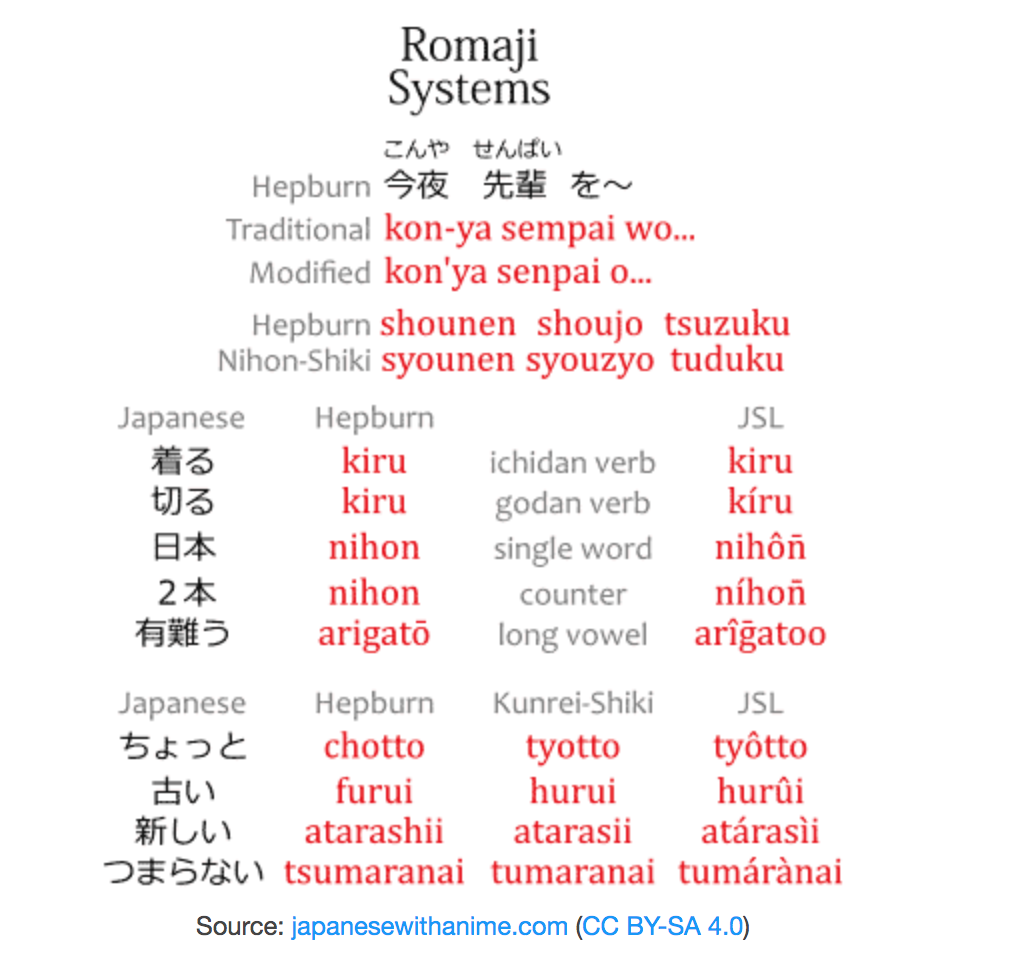Do we need to learn it?
The short answer is YES! Of course, any Japanese language learner needs to know Romaji’s rules, not only to understand how to read Japanese—which for Romance language speakers is not that difficult, even though it mixes phonetics from Romance and Anglo languages—but to use it when we have to.
Romaji, or romanization in English, is the word in Japanese that refers to the transliteration of Japanese for the Western world, a way to explain to foreigners how to actually read the three writing systems: Hiragana, Katakana, and Kanji. Transliterating means “to represent or spell in the characters of another alphabet”, (Merriam-Webster Dictionary).
The two major transliteration systems are Hepburn (1848) and Kunreishiki (1937). Recently, debates have been in favor to eliminate the late in order to adopt the first in the official romanization of the Japanese language.
But these are not the only systems in use nowadays. There are others too, like the Nihonshiki, an old version of the Kunreishiki; the JSL used mainly in Japanese Language Schools that emphasize phonetics above Romaji’s rules, and the Wapuro, which means ‘word processor’, which represents the way to type the Japanese language on a computer.
All of these systems have similarities and differences. Without a doubt, Hepburn is the most widely used, but it is not uncommon to find mixed usage in a given text. You can find more information about all these systems here.
When do we use Romaji?
One important thing is that Romaji turns out to be undoubtedly useful for students to understand Japanese language phonetics at the beginning of their learning journey. Each language has different sounds, so it is not adapted to each one individually, but once students learn the rules, it is easier for them to understand how to pronounce Japanese sounds, how to type on a computer or cellphone, and how to include Japanese words in another language’s text that uses the alphabet. There is not really a consensus on this topic, so each user of the system has to choose one. But most of the time, the Hepburn system prevails, even among Japanese people.
For example, you may find Romaji in places popular among travelers, like major train stations and tourist attractions. Also, many of the traffic signs include Romaji letters. Even at the supermarket, a lot of goods have alphabet words that could be the name of the brand or words in English explaining the characteristics of a product. And many companies are choosing to write their names in Romaji to be known broadly. On the internet, websites and email addresses need to be written in Romaji. But you will find the transliterations written in different ways, here is an example of the differences between the systems:

The History of Romaji
Before the adoption of the Hepburn system, there was a first attempt to romanize the Japanese language in the 16th century by the Portuguese, who were pioneer foreigners from the West trading with the Japanese while trying to disseminate the Catholic religion in Japan, and other Asian countries. Some important texts were transliterated into the Romance alphabet during that time, and they even wrote a Japanese-Portuguese dictionary which was intended to help them in the conversion of more Japanese people into Christianity.
During the Edo period (1603-1868) Romaji was not really in use, until the Meiji period (1868-1912) started. The so called Meiji Restoration marked a significant moment in the history of Japan when the country opened to the West and began adopting foreign cultures. At this point, Romaji started to be useful, that is why the American physician James Curtis Hepburn developed his Romaji system based on the one created at least three centuries before. According to nippon.com, he was sent to Japan by the Presbyterian Mission in 1859 and he got involved in many other activities like “promoting Western medicine, publishing the world’s first Japanese-English dictionary, translating the Bible into Japanese, high school education”, etc. More about Hepburn and his wife Clara here.
Wikipedia mentions that the Nihonshiki was invented in 1885 by the physicist Aikitsu Tadakanate, with the intention to replace the Hepburn system. Because all of his efforts, finally the Government adopted the Nihonshiki as the official transliteration system until it was replaced by the modern version called Kunreishiki, in 1937, imposed by the Ministry of Education. These two systems are similar and better adapted to the Japanese phonetics. For this reason, the Japanese students learn to romanize their language using the Kunreishiki in the school system. Actually, the Government still use it in official documents, even though for passports and street signaling the Hepburn system is preferred.
Romaji plays an important role in learning Japanese, but knowing and using it doesn’t actually mean that someone has mastered the language. We never recommend learning Japanese with an only Romaji approach, because it results unrealistic. You need to learn Hiragana and Katakana at the same time. Of course, Romaji has to be understood by every Japanese language student because it is not only a great tool, but also an important part of the learning process.
Three Websites to convert Kanji and Kana to Romaji
These websites can help you understad how to use Romaji while boosting your vocabulary and kanji readings:
1. NihongoDera offers free conversion on five different systems: Modified and Traditional Hepburn, Nihonshiki, Kunreishiki, and Wāpuro, to up to 10,000 characters. There are other features on this website, like an online dictionary. You can even add Furigana to your Kanji texts.
2. Romaji desu offers the conversion of romaji to kana and kanji and vice versa without specifying the Romaji system in use. There is also the option to translate on the site using Google Translation services.
3. With J-Talk you can convert up to 30,000 characters, with no specific system, but one can assume is Hepburn judging from the sample text at the end of the home page. They are transitioning to a better version and offer subscriptions with benefits like a bigger number of characters to convert at the same time and no ads. You can also translate to English on this site, they claim that their translations have a 99% accuracy rate.


Leave a Comment